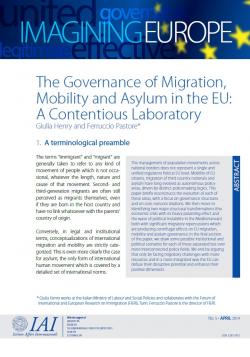The Governance of Migration, Mobility and Asylum in the EU: A Contentious Laboratory
The management of population movements across national borders does not represent a single and unified regulatory field at EU level. Mobility of EU citizens, migration of third country nationals and asylum have long evolved as autonomous policy areas, driven by distinct policymaking logics. This paper briefly reconstructs the evolution of each of these areas, with a focus on governance structures and on core-noncore relations. We then move to identifying two major structural transformations (the economic crisis with its heavy polarizing effect and the wave of political instability in the Mediterranean) both with significant migratory repercussions which are producing centrifugal effects on EU migration, mobility and asylum governance. In the final section of the paper, we draw some possible institutional and political scenarios for each of these separated but ever more interconnected policy fields. We end by arguing that only by facing migratory challenges with more resources and in a more integrated way the EU can defuse their disruptive potential and enhance their positive dimension.
Paper produced within the framework of the project "Towards a More United and Effective Europe". Presented at the IAI-CIDOB conference on "Migration and Mobility in Post-Crisis Europe", Barcelona, 6 May 2014.
-
Details
Roma, Istituto affari internazionali, April 2014, 43 p. -
In:
-
Issue
5
1. A terminological preamble
2. The evolution of the "core-noncore relationships" in the MAM policy fields
2.1. The core of mobility rights for EU citizens and the enlargement dynamic
2.2. The functionalist construction of the common migration policy: communitarisation through gradualism and flexibility
2.3. The Common European Asylum System: burden-sharing as a key driver
3. The upsurge of centrifugal forces in the MAM policy fields
3.1. Questioning mobility rights
3.2. The emergence of structural limits to European cooperation on migration
3.3. Formal and substantial burden-sharing in the management of mixed flows
4. Challenges ahead and potential governance implications
4.1. Free movement: a "hub and spoke" scenario?
4.2. Governance implications of a more effective policy on mixed flows
4.3. EU policy on labour migration: stagnation or breakthrough?
5. Concluding remarks
References
Topic
Tag
Related content
-
Event12/01/2015
Migration and Mobility in Post-Crisis Europe
leggi tutto -
Publication30/12/2014
Imagining Europe
leggi tutto -
Ricerca27/06/2013
Towards a More United and Effective Europe: Beyond the 2014 European Parliament Elections
leggi tutto



